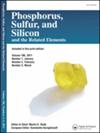Experimental investigation of pyridine removal using vulcanized oil shale
IF 1.4
4区 化学
Q4 CHEMISTRY, INORGANIC & NUCLEAR
Phosphorus, Sulfur, and Silicon and the Related Elements
Pub Date : 2025-01-02
DOI:10.1080/10426507.2025.2452211
引用次数: 0
Abstract
The study systematically conducted orthogonal and univariate experiments to determine the optimal parameters for pyridine removal using vulcanized oil shale. The findings revealed that the key determinants of pyridine adsorption onto vulcanized oil shale included the pH level of the pyridine solution, contact time, initial pyridine concentration, and the quantity of vulcanized oil shale introduced into the system. Under optimal adsorption conditions, the vulcanized oil shale achieved a 48.00% adsorption efficiency and an equilibrium adsorption capacity of 4.83 mg·g−1. In contrast, the untreated oil shale exhibited a comparatively reduced adsorption efficiency of 22.88% under its respective optimal conditions. The research further examined the adsorption kinetics and isothermal adsorption models for both types of oil shale. The kinetic data indicated that pyridine adsorption followed a pseudo-second-order model. The pyridine adsorption isotherms for both oil shale and vulcanized oil shale were best described by the Freundlich model, compared to the Langmuir model. These findings provide significant insights into the utilization of vulcanized oil shale for the efficient treatment of low-concentration pyridine wastewater, potentially contributing to environmental remediation and pollution control strategies.
硫化油页岩脱除吡啶的实验研究
通过系统的正交试验和单因素试验,确定硫化油页岩脱除吡啶的最佳工艺参数。结果表明,吡啶在硫化油页岩上吸附的关键决定因素包括吡啶溶液的pH值、接触时间、初始吡啶浓度和加入体系的硫化油页岩量。在最佳吸附条件下,硫化油页岩的吸附效率为48.00%,平衡吸附容量为4.83 mg·g−1。相比之下,未处理油页岩在其最佳条件下的吸附效率相对较低,为22.88%。进一步研究了两种油页岩的吸附动力学和等温吸附模型。动力学数据表明,吡啶的吸附符合准二阶模型。与Langmuir模型相比,Freundlich模型能更好地描述油页岩和硫化油页岩的吡啶吸附等温线。这些发现为利用硫化油页岩高效处理低浓度吡啶废水提供了重要见解,可能为环境修复和污染控制策略提供参考。
本文章由计算机程序翻译,如有差异,请以英文原文为准。
求助全文
约1分钟内获得全文
求助全文
来源期刊
CiteScore
2.60
自引率
7.70%
发文量
103
审稿时长
2.1 months
期刊介绍:
Phosphorus, Sulfur, and Silicon and the Related Elements is a monthly publication intended to disseminate current trends and novel methods to those working in the broad and interdisciplinary field of heteroatom chemistry.
文献相关原料
公司名称
产品信息
阿拉丁
Pyridine
阿拉丁
Sodium hydroxide
阿拉丁
Sulfur
阿拉丁
Hydrochloric acid

 求助内容:
求助内容: 应助结果提醒方式:
应助结果提醒方式:


